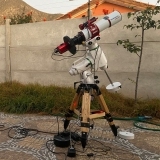INDI Library v2.0.7 is Released (01 Apr 2024)
Bi-monthly release with minor bug fixes and improvements
ASI2600MM-P produces 14-bit images
- Konstantin Baranov
-
Topic Author
- Offline
- Senior Member
-

- Posts: 50
- Thank you received: 6
Replied by Konstantin Baranov on topic ASI2600MM-P produces 14-bit images
With DR below 14 there is probably very little advantage of 16-bit data over 14-bit. So it's not a big issue, but still curious.
Please Log in or Create an account to join the conversation.
- Wouter van Reeven
-

- Offline
- Supernova Explorer
-

- Posts: 1957
- Thank you received: 420
Replied by Wouter van Reeven on topic ASI2600MM-P produces 14-bit images
Please Log in or Create an account to join the conversation.
- Konstantin Baranov
-
Topic Author
- Offline
- Senior Member
-

- Posts: 50
- Thank you received: 6
Replied by Konstantin Baranov on topic ASI2600MM-P produces 14-bit images
Please Log in or Create an account to join the conversation.
- Wouter van Reeven
-

- Offline
- Supernova Explorer
-

- Posts: 1957
- Thank you received: 420
Replied by Wouter van Reeven on topic ASI2600MM-P produces 14-bit images
Please Log in or Create an account to join the conversation.
- Konstantin Baranov
-
Topic Author
- Offline
- Senior Member
-

- Posts: 50
- Thank you received: 6
Replied by Konstantin Baranov on topic ASI2600MM-P produces 14-bit images
Please Log in or Create an account to join the conversation.
- Wouter van Reeven
-

- Offline
- Supernova Explorer
-

- Posts: 1957
- Thank you received: 420
Replied by Wouter van Reeven on topic ASI2600MM-P produces 14-bit images
Please Log in or Create an account to join the conversation.
- Konstantin Baranov
-
Topic Author
- Offline
- Senior Member
-

- Posts: 50
- Thank you received: 6
Replied by Konstantin Baranov on topic ASI2600MM-P produces 14-bit images
Please Log in or Create an account to join the conversation.
Replied by nou on topic ASI2600MM-P produces 14-bit images
Please Log in or Create an account to join the conversation.
- Konstantin Baranov
-
Topic Author
- Offline
- Senior Member
-

- Posts: 50
- Thank you received: 6
Replied by Konstantin Baranov on topic ASI2600MM-P produces 14-bit images
Please Log in or Create an account to join the conversation.
- Peter Sütterlin
-

- Offline
- Supernova Explorer
-

- Posts: 1009
- Thank you received: 133
Replied by Peter Sütterlin on topic ASI2600MM-P produces 14-bit images
Please Log in or Create an account to join the conversation.
Replied by PDB on topic ASI2600MM-P produces 14-bit images
i think (almost?) every ZWO camera has high-speed built in. By reducing the ADC bit depth it can speed up captures (in some cameras capture-rate doubles). This mode is not useful for deep-sky, but mainly for high-speed video capture. But this will have impact on Dynamic Range. Sometimes I use that if I want to capture ISS transits. There I need high-frame rate, and can afford less dynamic range. In planetary 8bit recordings are often used and higher capture speeds can be achieved. (However these are mostly dependant on exposure time).
Paul
Please Log in or Create an account to join the conversation.
- Konstantin Baranov
-
Topic Author
- Offline
- Senior Member
-

- Posts: 50
- Thank you received: 6
Replied by Konstantin Baranov on topic ASI2600MM-P produces 14-bit images
Please Log in or Create an account to join the conversation.
